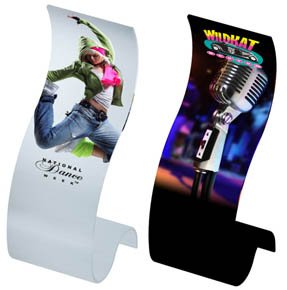Banners and Signs with Text, Oh My!
No matter how many high-tech gizmos, iPad kiosks, social media enhancements, or whatever other new tricks you include in your trade show displays, there are still going to be a few constants. Text is one of them. While the idea of an expo display entirely without any text copy might be an interesting idea to explore, at the end of the day, almost every display stand is going to have text, and probably quite a lot of it.
It seems like such a basic thing, but think about all the places in a trade show booth you’re going to have to put text of some sort or another:
1) All your trade show banners and signage.
2) Any coverings for your display stands and trade show counters.
3) Any copy on all printed materials you have.
4) You may have digital items, like DVDs or USB drives that contain more material.
5) Instructions for use on any demo materials you might have out.
6) Plus, of course, that’s not to mention all the various places your company name, employee’s names, address, and other contact information will be printed.
A lot of text, and a lot of writing goes into a successful stand up banner or trade show booth. Here are some things to keep in mind!
First and Most Importantly…
Proofread everything multiple times. By multiple people. Repeatedly. No matter how often you look over the same pieces of copy, you are going to keep catching mistakes. Use computer spell checkers too, and then look carefully at words (like your boss’s name!) that spell checkers won’t check.
There really cannot be enough proofing when it comes to copy at your trade show displays. We’d suggest looking into collaborative tools, like Google Documents, which allow multiple people to all work with the same document online. These make it far easier for more people to contribute to them, or at least help look them over for errors.
Every typo caught before it appears at your expo booth is potentially another lead saved who would have otherwise dismissed you as amateurs. Nor do you want your display to be the subject of an online joke after the show (example – cost of printed graphic, $1000. Cost of overnight shipping it to the show, $150. Cost of having the CEO’s name misspelled on it – priceless.)
Writing Materials for Your Expo Displays
If you can afford it, it’s usually better to create new brochures and other written materials which are tailored to each specific trade show.
While it’s understandably tempting to reuse your ordinary brochures, that’s the problem – they’re ordinary. When a trade show guest is rummaging through their swag bag at the end of the day, they are going to ignore the brochures that they’ve seen before, or that look like they’ve lived for months in a corporate lobby or waiting room.
So experiment with designs, and look for ways to make your trade show printed materials stand out when they’re competing against a large stack of brochures.
Right now, marketing copywriting tends to be stripped-down. People are well aware of the ability of advertising materials to mislead them, and tend to be deeply suspicious of companies who seem to be using “tricks” in their writing.
7 Tips for Making your Trade Show Advertising Copy More Effective:
- Avoid open appeals to emotion that aren’t balanced by reason and facts as well. Older visitors respond better to emotional appeals; folks under 40 tend to be less impressed the younger they get.
- Use as little jargon as possible while still establishing yourself as a credible member of your industry. Your materials should be readable by pretty much anyone who’d have a reason to be interested in your field. Try not to assume too much prior knowledge on the part of your booth visitors.
- Don’t use managerial buzzwords or “corporate speak” unless you’re specifically targeting C-level executives. Those throw up red flags for everyone else.
- Speaking of CxOs, remember that they rely on others to filter information. You can often do better writing towards the CEO’s personal assistant than to the CEO directly. That is to say, something is a lot more likely to end up on the boss’s desk if their secretary read it and liked it or thought their boss would want to see it. (Should they be one of your target persona’s?)
- Be engaging. Use the Active Voice whenever possible. It uses less words, is generally clearer, and tends to make people react more positively. This is especially true for any banner stands or other “headline” materials.
- Don’t tell people what they do think, or will think. People are very possessive of their thoughts right now. Future expectations should be expressed in concrete terms as much as possible. Statements like “You’ll see the future in a whole new way with Acme!” tend to invite skepticism rather than excitement.
- Focus on collaborative possibilities. Your product isn’t an end unto itself; it’s a springboard to allow your expo visitors to achieve their dreams and goals. Try to use “we” words, as in how you and your visitor together can do more than either can individually.
And most importantly here, keep the copy honest. Most people now carry smartphones that can fact-check almost anything at a moment’s notice, even while they’re browsing your expo booth. Don’t make any claims you can’t back up factually, or it can become embarrassing, quickly.
Remember the Written Word in Your Trade Show Displays
When you’re putting your trade show display materials together, your written copy should receive a lot of attention. Despite all the other toys and gimmicks, it’s your text that’s going to be converting people as much as anything else at your booth. Everything needs to be as well-written as possible if you’re going to pick up all the leads you want!
